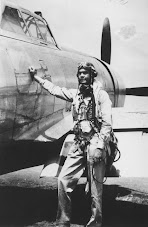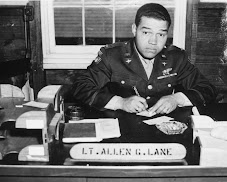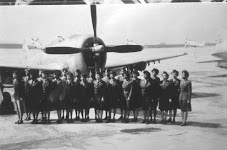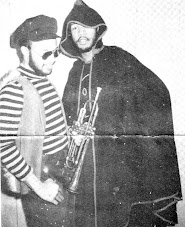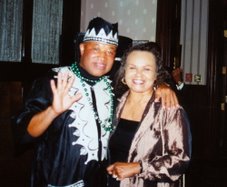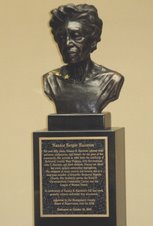
Celebration of Life, Tuesday Dec. 18, 2007, 11 am., Bethany Lutheran Church, Forestville, Maryland.
I must have made five hundred trips to Cleveland, Ohio through the decades and ninety percent of the destinations ended up at 841 Linn Drive in Glenville. My vehicles could make the drive without me, they knew the route through those mean streets so well.
I had my own set of keys to the building and occasionally Grandad and Annette would be out when I arrived; no problem. I think they married in 1969; if I recall, they met in Charleston, West Virginia and played cards with Tom and Roberta Watkins, Grandad's long friends.
I often wonder how they stayed so happily together in that tiny, two bedroom apartment? I guess when the price is right, you make do with your surroundings. Grandad was the building superintendent, trading his maintenance and management skills for the rent and didn't dent his meager miner's pension with housing expense.
But the apartment space was so close they had to utilize every square inch to store a lifetime of collectibles. I remember that the closet in the guest room was full of extra suits, dresses, hats, scrapbooks, sewing equipment, the sweeper, extra canned and boxed goods. The drawers of the dresser were crammed with tools, papers and general stuff.
Even though the kitchen wasn't as big as a minute, there was room for a China cabinet for her collectible glassware items, a large fridge, an electric range and a table by the window that would seat three, if forced to. Many of my favorite moments on this Earth were spent in that humble twenty-four square feet of yellow painted wall space.
The foods that were served in the Williams' kitchen had soul. Cornish game hens, ham, capon and an occasional chicken were baked under those glowing elements, as well as packages of dinner rolls and tins biscuits. Mashed potatoes, eggs, potatoes and onions, bacon, green beans, peas and gravies came to life on the top of the range.
I never learned the recipe for the sweet tea that Annette served; nothing I have tasted in this world rivaled its mellow flavor. Now that I know that she has passed on, I'm starting to get teary, for I shall never fill another eight ounce glass with that wonderful blend of Lipton, sugar and lemon.
My tastebubs have memories of moist turkey dressing, slices of white meat and potatoes swimming in perfectly prepared gravy. Green bean with the smoked taste of a salty ham, sweet potatoes and candied yams to died for. Rolls and soft tubs of margarine, dreaded trips to the neighborhood market, because the meal wouldn't be right unless we had cranberry sauce. Wheaties, ripe bananas, toast from a vintage toaster, grape jelly...
In that space at 841 Linn Drive, I would feel no guilt about having, seconds and just a dab of thirds. For me, soul foods delivered there were like nowhere else. Tony Bennett's heart is in San Francisco, but God knows that mine is in Glenville in my grandpeople's greasy kitchen.
I remember the summer of 2003 was Bob and Annette's last on Linn Drive. The building was not the same strong building as when Grandad inherited its upkeep in 1969. I had gone up for a Cleveland Rockers basketball game in August and when I pulled into the parking lot on Prospect Street, the lot attended told me that the game had been canceled because the power in the city had gone down.
I made a risky beeline (no traffic signals) to Linn Drive, because that August day was stiflingly hot. When I arrived, it took two sweltering hours to talk the old folks into packing an overnight bag and coming south to Columbus or at least to a local motel in the suburbs, where there might be electricity and air conditioning.
We, and the thousands of other victims of a power outage that blanketed the Midwest, East Coast and parts of Canada, drove for three hours, before we got to the nearest available motel in Ashland, Ohio, eighty miles south of Cleveland. I got two rooms and we were comforted. We got up the next morning and power had been restored, so we drove back to Glenville.
With grateful heart, I am thankful for the years that Grandad and Annette comforted and loved each other and the many miles that they traveled safely on the highways visiting friends, attending school reunions, church functions, attending funerals and family holidays. Their favorites were Memorial Day, to decorate the graves of her loved ones in West Virginia, the Gary District High School Reunions and the Pig Roast and Family Days in Plain City, Ohio. They would gather up a carload of the Cleveland Family and strike out for a long day trip to the country and the fellowship of our extended Frazier Family.
When they stopped coming to the Pig Roast during the 2001 Labor Day, I knew that Father Time had caught up with them. But Bob and Annette Williams sure gave the Old Guy a great run, staying active well into their eighties. Perhaps their time together in heaven be full of friends, card games, soulful meals and nice cars. I hope so.
Bright moments from your loving grandboy,
Arnett

